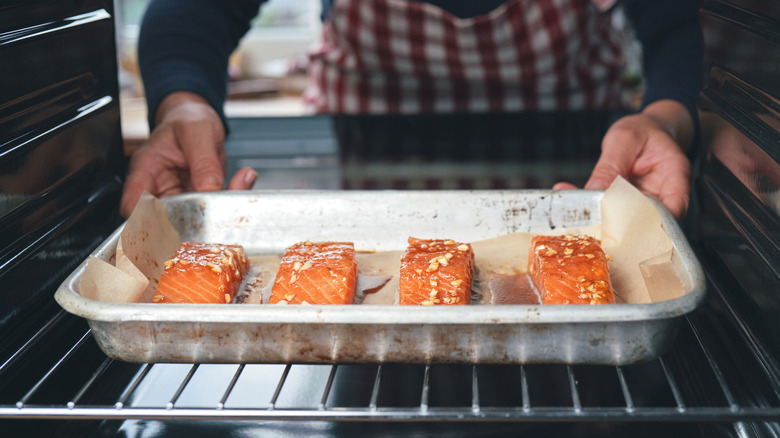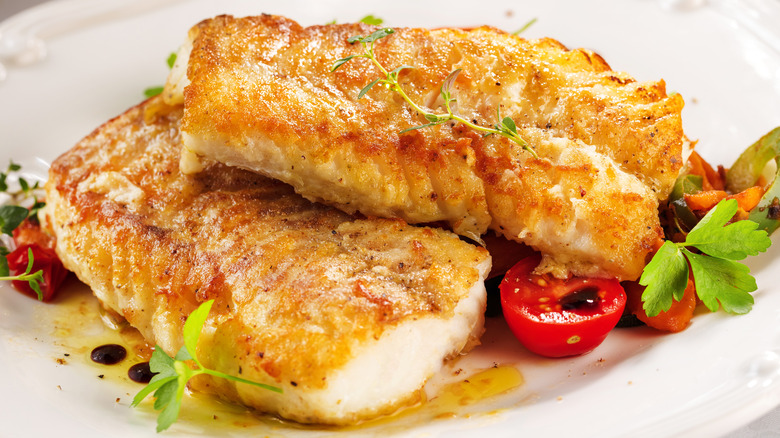Eric Ripert's Skewer Tip To Tell When Fish Is Done Cooking
Cooking fish can seem daunting, with one of the main reasons being the fear of under- or overcooking it. You could wind up with a filet that's still very soft and see-through in the center, or has turned tough and rubbery. Seafood isn't always the cheapest protein to buy, either, so getting it wrong can be an expensive mistake. Learning how to tell when the fish is cooked to perfection can help soothe your nerves, and Michelin-starred chef and author Eric Ripert has a great method to share.
Before you even start cooking, a few prep tips can help you along to success, such as cutting an uneven piece of fish for even cooking or patting it dry before it goes into the pan to ensure a better sear. As the fish cooks, Ripert recommends inserting a metal skewer into the meat, then holding the skewer to your wrist to check how warm it feels. The temperature of the skewer can tell you how far along your fish is, without having to use an actual thermometer (not every cook owns one, after all).
This trick works for all sorts of types of fish, as well as different methods of preparation and cooking styles, from sautéed cod or a simple Dijon-crusted salmon recipe to poached snapper. Follow Ripert's steps for pulling it off, and cooking a seafood dinner will seem much less intimidating.
Test the temperature of fish with a skewer and your senses
To eliminate bacteria and pathogens, the USDA states that seafood should be cooked until it reaches an internal temperature of 145 degrees Fahrenheit. However, many chefs prefer to cook fish below this stage of doneness, so it doesn't become dry and tough. If you're also willing to take this small risk, Eric Ripert's technique is right for you, since it relies on the senses rather than an exact temperature.
The chef recommends sticking a metal skewer into the thickest park of a fish filet and holding it for five seconds, so it can absorb the internal heat. Remove the skewer and hold it to your wrist — you want it to feel warm (but not hot), so if it's cool, continue to cook the fish for a brief period before checking again. If the skewer is hot, take the fish off the heat right away. When the skewer pokes into perfectly-done fish, you'll feel just a slight amount of resistance. If you don't have a skewer, you could also use a cake tester.
One disadvantage of Ripert's tip is that it may not be the most accurate for inexperienced home cooks. A warm temperature suggests a medium-rare result, Ripert says, but "warm" is a vague term and could mean different things to different people. There are other methods you can try in addition to the skewer trick to make doubly sure your fish is done to your liking.
Other tips to check fish is properly cooked
There's a 10-minute rule for cooking fish: Measure the raw filet at its thickest part, then cook for 10 minutes for every inch, at a medium temperature (about 350 degrees Fahrenheit). Turn the filet halfway through the cooking time. Of course, this is just a guideline, and it can vary depending on the piece of fish and cooking method. How long to cook salmon in an air fryer will depend on the filet's size, but this appliance will be quicker than the oven. The 10-minute guide can be helpful, but you should also keep an eye on your fish and test for doneness more than once.
One trick involves inserting a fork into the thickest part of the filet, but instead of feeling how warm the utensil is, twist it gently to flake the fish. You're looking for flesh that flakes apart easily, and does not look translucent in the center. If the meat is difficult to flake, give it a little longer to cook before testing again.
Another method is to cut into the thickest part of the fish and simply observe the appearance and color. The interior should be opaque, rather than translucent. If you don't want to break up your piece of fish, and you're not confident about the skewer test, you'll have to invest in a thermometer. It offers the most accuracy regarding the doneness of your fish, for cooks who really want control over the whole process.



